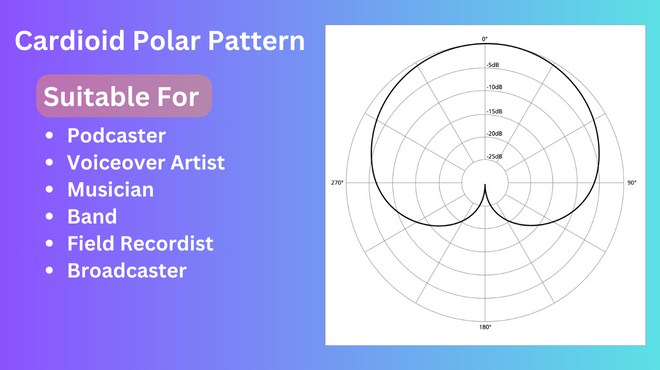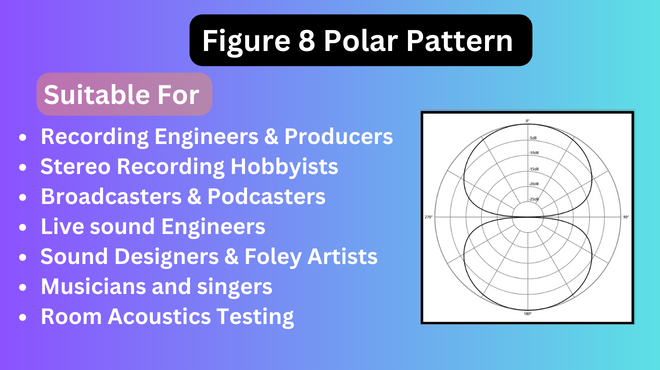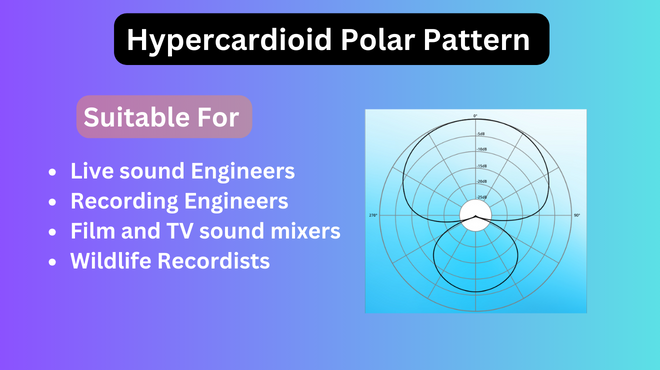Supercardioid Polar Pattern Demystified
It is crucial to have crystal-clear sound quality in the field of audio technology. As audio lovers, experts, and content producers, we are always looking for methods and equipment that will help us produce the best possible sound recordings. The supercardioid polar pattern is one such instrument that has evolved into a necessity in the field of microphones.
Unlocking the Supercardioid Advantage
The supercardioid polar pattern, which was painstakingly created to record sound with unmatched precision and clarity, is at its core a feat of engineering brilliance. In this thorough investigation, we delve into the minute particulars of this extraordinary microphone function, revealing its mysteries and illuminating its varied applications.
The Supercardioid Mystery: Solved
Supercardioid microphones have become quite popular due to their prowess in difficult acoustic conditions. They are an excellent option for a variety of recording circumstances because they provide a special combination of focused directionality and decreased sensitivity to off-axis noises. Understanding the super-cardioid polar pattern is crucial whether you’re a seasoned audio engineer, a podcaster seeking flawless voice recordings, or a musician hoping to capture the subtleties of your performance. The theory behind super-cardioid microphones will be dissected in the following sections, along with how they differ from other polar patterns and how to use them most effectively in various recording scenarios.
What is a Supercardioid Polar Pattern?
A Supercardioid Polar Pattern is a directional microphone pickup pattern characterized by its narrow, focused sensitivity to sound sources directly in front of the microphone while rejecting much of the sound coming from the sides and rear. This pattern resembles a tighter version of the cardioid pattern, providing excellent off-axis rejection and minimizing background noise pickup.
Why should you use an Supercardioid polar pattern?
Without a doubt, let’s get into more detail about the following reasons why you ought to think about employing a Super cardioid polar pattern when recording audio and amplification:
1. Supercardioid Polar Pattern Precision:
Unmatched accuracy in audio capturing is provided by the Super cardioid polar pattern. It prioritizes sound sources that are right in front of the microphone because of its extremely directional construction. When you want to isolate a particular audio source while reducing interference from outside noise, this accuracy is essential. The Supercardioid pattern makes sure that the intended sound source takes center stage, improving overall audio quality, whether you’re podcasting, recording vocals in a studio, or amplifying an instrument during a live performance.
2. Supercardioid Pattern Noise Rejection Advantage:
The Super cardioid pattern outstanding off-axis rejection is one of its most notable characteristics. This indicates that it effectively cancels out sound emanating from the microphone’s sides and back. It is perfect for noisy environments, live concerts, and outdoor events because of its outstanding background noise reduction capabilities. Supercardioid microphones allow for clean, distortion-free recordings and interference-free amplification of sound sources because they minimize the pickup of background noise.
3. Supercardioid Pickup Pattern for Feedback Control:
Feedback can pose a serious problem for live sound reinforcement. In this regard, supercardioid microphones excel. Even when the microphone is placed close to loudspeakers, the off-axis rejection and directional nature of these components decrease the chance of feedback. This feedback control ensures a seamless and uninterrupted audio experience for both the audience and the artists during live performances, conferences, and speaking engagements.
4. Supercardioid Microphones in Studio Recording:
Recording studios are a natural place for super cardioid microphones. They are used by musicians and audio engineers to precisely record individual instruments, vocals, and acoustic sources. The Supercardioid polar pattern isolates the intended sound source and lessens bleed from surrounding instruments, enabling controlled, high-quality recordings of delicate acoustic guitars, dynamic voice performances, or thundering drum kits.
5. Supercardioid Versatility in Various Applications:
Although frequently used for recording vocals and instruments, Supercardioid microphones are adaptable devices that have uses beyond these. They are used to concentrate on particular sound sources and ensure clear audio in a variety of acoustic situations in broadcasting, podcasting, field recording, and film production. Due to its adaptability, Supercardioid mics are fundamental pieces of gear for audio professionals looking for the best possible sound quality and clarity in a variety of settings.
Which microphones use Supercardioid Polar Patterns?
Various microphones for a range of applications frequently employ super-cardioid polar patterns. The following are some common microphone types that frequently use the Super-cardioid polar pattern:
Dynamic Microphones:
Super cardioid polar patterns are used in dynamic microphones intended for live sound reinforcement. Stage artists favor these mics because they can reject background noise and reduce feedback.
Condenser Microphones:
Supercardioid polar patterns are available on some condenser microphones, particularly those designed for studio recording. Due to its adaptability, the microphone may be used to record in a variety of settings, such as isolating vocals or instruments in a controlled studio environment.
Shotgun Microphones:
The “Lobar” pattern, which is an even more directed variant of the Super cardioid pattern, is frequently used by shotgun microphones. These microphones are frequently used to record focused audio in outdoor and on-location environments for film and video production.
Lavalier Microphones:
Super-cardioid polar pattern options are available on several lavalier (lapel) microphones. In broadcast, theater, and public speaking applications, this can help lower background noise and enhance speech understanding.
Boundary Microphones:
A Super-cardioid pattern may be used in boundary microphones made for conference rooms and boardrooms to pick up sound from a particular direction while reducing background noise.
Instrument Microphones:
In both live and studio situations, super-cardioid microphones are frequently used to mic certain musical instruments, such as drums, brass instruments, and acoustic guitars.
Podcast and Broadcasting Microphones:
Super cardioid polar patterns are included in some microphones made specifically for podcasting and broadcasting purposes. Thus, background noise and room reverberation are reduced while background voice recordings are kept clear for podcasters and broadcasters.
When would you use a supercardioid polar pattern?
The Super cardioid polar pattern is a versatile choice for microphones and is used in a variety of situations where precise sound capture and noise rejection are essential. Here are some scenarios in which you would use a super-cardioid polar pattern:
- Live Sound Reinforcement: Supercardioid microphones are commonly used on stage to capture individual instruments, vocals, or speakers. They excel at isolating the intended sound source while minimizing feedback and rejecting background noise from other instruments and stage monitors.
- Studio Recording: In a controlled studio environment, Supercardioid microphones are employed to isolate and record specific instruments or vocalists. They provide excellent off-axis rejection, reducing bleed from nearby sources, which is crucial for achieving clean and professional recordings.
- Podcasting and Broadcasting: Supercardioid microphones are popular choices for podcasting and broadcasting studios. They allow hosts and broadcasters to capture clear and focused voice recordings while minimizing the pickup of room noise or off-mic sounds.
- Field Recording: When recording audio in outdoor or field environments, Supercardioid microphones can be effective for isolating sound sources such as wildlife, dialogues, or specific noises while minimizing ambient noise interference.
- Interviews and Roundtable Discussions: Supercardioid microphones are suitable for recording interviews and discussions involving multiple speakers. They focus on the speaker in front of the microphone while reducing the pickup of voices from the sides and rear.
- Theater and Performances: In theatrical productions, Supercardioid microphones are used to capture the dialogues and performances of actors on stage. They offer feedback control and minimize ambient noise pickup.
- Instrumental and Vocal Performances: Musicians use Supercardioid microphones for miking individual instruments, amplifiers, and vocalists during live performances and studio recording. This ensures that the desired sound source is captured with clarity.
- Video Production: Supercardioid shotgun microphones are often used in film and video production to capture directional audio for on-screen dialogues and sound effects while rejecting off-axis noise.
- Educational and Conference Settings: In classrooms, lecture halls, and conference rooms, Supercardioid microphones can be used for recording lectures and discussions, ensuring clear audio capture of the speaker without picking up excessive room noise.
- Noise-Critical Environments: Supercardioid microphones are valuable in environments where minimizing background noise and capturing specific sound sources are critical, such as law enforcement audio recording or surveillance applications.



